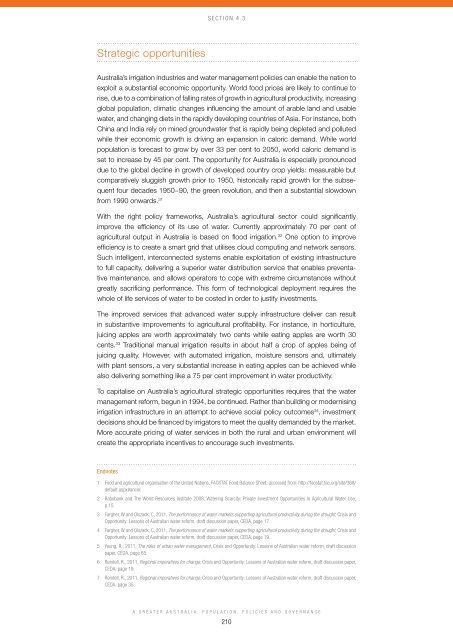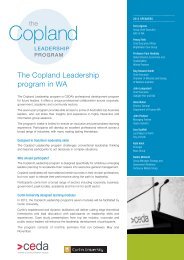A Greater Australia: Population, policies and governance - CEDA
A Greater Australia: Population, policies and governance - CEDA
A Greater Australia: Population, policies and governance - CEDA
- No tags were found...
You also want an ePaper? Increase the reach of your titles
YUMPU automatically turns print PDFs into web optimized ePapers that Google loves.
Section 4.3Strategic opportunities<strong>Australia</strong>’s irrigation industries <strong>and</strong> water management <strong>policies</strong> can enable the nation toexploit a substantial economic opportunity. World food prices are likely to continue torise, due to a combination of falling rates of growth in agricultural productivity, increasingglobal population, climatic changes influencing the amount of arable l<strong>and</strong> <strong>and</strong> usablewater, <strong>and</strong> changing diets in the rapidly developing countries of Asia. For instance, bothChina <strong>and</strong> India rely on mined groundwater that is rapidly being depleted <strong>and</strong> pollutedwhile their economic growth is driving an expansion in caloric dem<strong>and</strong>. While worldpopulation is forecast to grow by over 33 per cent to 2050, world caloric dem<strong>and</strong> isset to increase by 45 per cent. The opportunity for <strong>Australia</strong> is especially pronounceddue to the global decline in growth of developed country crop yields: measurable butcomparatively sluggish growth prior to 1950, historically rapid growth for the subsequentfour decades 1950−90, the green revolution, <strong>and</strong> then a substantial slowdownfrom 1990 onwards. 31With the right policy frameworks, <strong>Australia</strong>’s agricultural sector could significantlyimprove the efficiency of its use of water. Currently approximately 70 per cent ofagricultural output in <strong>Australia</strong> is based on flood irrigation. 32 One option to improveefficiency is to create a smart grid that utilises cloud computing <strong>and</strong> network sensors.Such intelligent, interconnected systems enable exploitation of existing infrastructureto full capacity, delivering a superior water distribution service that enables preventativemaintenance, <strong>and</strong> allows operators to cope with extreme circumstances withoutgreatly sacrificing performance. This form of technological deployment requires thewhole of life services of water to be costed in order to justify investments.The improved services that advanced water supply infrastructure deliver can resultin substantive improvements to agricultural profitability. For instance, in horticulture,juicing apples are worth approximately two cents while eating apples are worth 30cents. 33 Traditional manual irrigation results in about half a crop of apples being ofjuicing quality. However, with automated irrigation, moisture sensors <strong>and</strong>, ultimatelywith plant sensors, a very substantial increase in eating apples can be achieved whilealso delivering something like a 75 per cent improvement in water productivity.To capitalise on <strong>Australia</strong>’s agricultural strategic opportunities requires that the watermanagement reform, begun in 1994, be continued. Rather than building or modernisingirrigation infrastructure in an attempt to achieve social policy outcomes 34 , investmentdecisions should be financed by irrigators to meet the quality dem<strong>and</strong>ed by the market.More accurate pricing of water services in both the rural <strong>and</strong> urban environment willcreate the appropriate incentives to encourage such investments.Endnotes1 Food <strong>and</strong> agricultural organisation of the United Nations, FAOSTAT Food Balance Sheet, accessed from: http://faostat.fao.org/site/368/default.aspx#ancor.2 Rabobank <strong>and</strong> The World Resources Institute 2008, Watering Scarcity: Private Investment Opportunities in Agricultural Water Use,p.15.3 Fargher, W <strong>and</strong> Olszack, C, 2011, The performance of water markets supporting agricultural productivity during the drought, Crisis <strong>and</strong>Opportunity: Lessons of <strong>Australia</strong>n water reform, draft discussion paper, <strong>CEDA</strong>, page 174 Fargher, W <strong>and</strong> Olszack, C, 2011, The performance of water markets supporting agricultural productivity during the drought, Crisis <strong>and</strong>Opportunity: Lessons of <strong>Australia</strong>n water reform, draft discussion paper, <strong>CEDA</strong>, page 19.5 Young, R., 2011, The risks of urban water management, Crisis <strong>and</strong> Opportunity: Lessons of <strong>Australia</strong>n water reform, draft discussionpaper, <strong>CEDA</strong>, page 65.6 Rendell, R., 2011, Regional imperatives for change, Crisis <strong>and</strong> Opportunity: Lessons of <strong>Australia</strong>n water reform, draft discussion paper,<strong>CEDA</strong>, page 19.7 Rendell, R., 2011, Regional imperatives for change, Crisis <strong>and</strong> Opportunity: Lessons of <strong>Australia</strong>n water reform, draft discussion paper,<strong>CEDA</strong>, page 35.A <strong>Greater</strong> <strong>Australia</strong>: <strong>Population</strong>, Policies <strong>and</strong> Governance210





